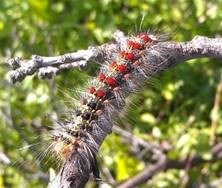The Gypsy moth caterpillar consume tremendous amounts of leaf material in the spring, as much as one square foot of leaves per day.
A solution to the Gypsy moth problem emerged in Europe in 1938, where they began to use B.T.K. (Bacillus thuringiensis kurstaki) on forests and agricultural lands as a biological insecticide to exterminate the gypsy moth.
B.T.K. is a naturally occurring bacteria the soil. In North American, it wasn’t until the 1970s that B.T.K. was used to eradicate the caterpillar on millions of hectares of forest.
Apparently it is very low risk to humans, animals, birds and fish. B.T.K. effects caterpillars yet doesn’t harm bees, lady beetles, ants or parasitic wasps.
It is applied either by helicopters, small planes or by ground application, usually in April and May when the gypsy moth caterpillars hatch and begin to feed. When the caterpillars munch the vegetation, the B.T.K. consumed activates in their digestive system and is fatal within hours.
Go Green Pest Control owner Randy Bilesky is a long-time South Delta resident. Trained and certified, Bilesky has first-hand knowledge of the pest problems that local homeowners and business owners encounter.


